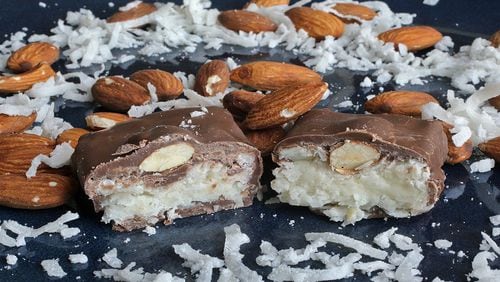You can show your family and friends that you truly care about them by giving them your own homemade chocolate candy bars.
Just as a side note, of course, the happy recipients are certain to be impressed — stunned, actually — and grateful.
Why grateful? Because these things are truly, truly good.
“Your Snickers are better than actual Snickers,” said one taste-tester.
“Your Twix are better than actual Twix,” said another.
I made homemade knockoffs of several popular chocolate candy bars. As is so often the case, homemade is better than the commercial versions, or at least as good. But I have to admit that, in this case, homemade is also more expensive and more time-consuming than going to the local 7-Eleven and grabbing a Kit Kat bar.
Except Kit Kat bars. Making your own Kit Kat bars is surprisingly fast and easy and cheap.
There are two secrets. Secret No. 1 is important — nearly necessary — for making any candy bar at home: Don’t use regular chocolate; use chocolate candy coating. Chocolate, after it melts and hardens, turns brittle and fails to adhere to whatever you are trying to coat. Candy coating, on the other hand, is softer and makes the perfect exterior for any confection.
You can find chocolate candy coating, also called melting wafers, in the baking aisle of most grocery stores (Wilton and Baker’s are popular brands). You can get the same effect by tempering regular chocolate, but it takes a long time and requires a fairly high degree of precision. For home cooks, I don’t recommend it.
Secret No. 2 only concerns Kit Kat bars: They are ridiculously easy. You know those sugar wafers you can get at any store? Dip them in melted chocolate candy coating. Congratulations, you have Kitty Kat bars.
I next tried something much harder, faux Butterfingers bars called Nutterfingers. The hard part comes in creating that distinctive crunchy peanut-butter filling in the middle.
Even so, all it takes is patience, and then speed. The patience part comes when you bring a boiling mixture of sugar, water and corn syrup to 300 degrees. The temperature rises slowly, and it stops altogether at 220 degrees for a couple of minutes until it begins creeping upward again.
Then comes the speed part. When it hits 300 degrees, you immediately dump in a mixture of peanut butter, vanilla extract and baking soda, and quickly stir to mix. Still acting fast, you spread this combination out onto a prepared baking dish before it can solidify and crumble.
I tried it twice, and both times I got some crumbling.
Then comes the patience part again. You have to wait at least four hours before you can coat the bars with chocolate. But it is definitely worth the wait. It is even worth the crumbling.
Homemade Almond Joy bars were next, which I am calling Almond Happiness. Ordinarily, I am not a fan of Almond Joy bars, but these are not ordinary.
They are extraordinary. The filling comes from a lot of sweetened, shredded coconut stirred into a mixture of condensed milk and powdered sugar, plus a hit of vanilla and salt. The only problem is that this filling is very tough to stir.
I’ve been working out. You’re on your own.
You need toasted almonds, of course, for Almond Joy or Almond Happiness, and my almonds tended to fall off into the chocolate. But that’s not too big of a problem. A few of my candies just became Hills bars.
I next made what I believe we can call Peanut Butter Cups. That’s chocolate on the bottom, a just-right layer of peanut butter (mixed with powdered sugar and melted butter) in the middle and more chocolate on top.
These are slightly more difficult to make than they sound, but only slightly. Very slightly. When you pour the chocolate in the bottom of the cup for the first layer, you have to spread it around the edges. That’s not hard, but the whole batch will take several minutes to do it. Feel free to use your finger to help do the spreading, as long as it is impeccably clean. Then add chocolate on top.
They taste every bit as wonderful as the real thing. You can just imagine all those workers in Hershey, Pa., using their impeccably clean fingers to spread chocolate around the edges.
Next, I made what are called Resolution Breaker bars, but which taste like Snickers bars (though, as we have seen, they are better). The trick here is to make a nougat, and the traditional way to make nougat is time-consuming and, frankly, a little annoying.
So I went with the nontraditional method featured in the recipe, which comes from Oh! Nuts. Timing is important here, too, because once you have a mixture of butter, sugar and evaporated milk boiling you quickly have to stir in a combination of peanut butter, vanilla and marshmallow creme.
Ordinarily, I stay away from marshmallow creme (or anything that spells it “creme”), but it makes sense when making nougat.
Resolution Breaker bars require several steps — nougat, peanut-filled caramel and chocolate — and so do bars I’m going to call Twicks. With Twicks bars, you begin with a cookie, but it is a fairly soft cookie so you use cake flour (a little less all-purpose flour will do, too).
A caramel layer is next, and although it involves melting and stirring and judging how much cream to add, the only hard part is unwrapping all those little caramels.
You have to refrigerate each layer as you make it, so it takes a little time. But anticipation only makes homemade candy bars better.
When you give them to your friends and relations, and their children, be sure to save a couple for yourself.
———
KITTY KAT BARS
Yield: 18 servings
18 sugar wafers
10 ounces chocolate candy coating or tempered chocolate
Line a baking sheet with waxed paper. Melt chocolate in a microwave or double boiler, stirring frequently, until smooth. Use forks or a dipping tool to dunk each wafer in the chocolate, covering it completely and place on the prepared baking sheet. Refrigerate until set, about 15 minutes. These bars may be stored in an airtight container for 1 week.
Per serving: 121 calories; 7 g fat; 6 g saturated fat; no cholesterol; 1 g protein; 14 g carbohydrate; 12 g sugar; 1 g fiber; 19 mg sodium; 23 mg calcium
Recipe from thespruce.com
NUTTERFINGERS BARS
Yield: 20 servings
1 cup chunky peanut butter
3/4 teaspoon baking soda
1 teaspoon vanilla extract
2 cups granulated sugar
1/2 cup water
3/4 cup light corn syrup
16 ounces chocolate candy coating or tempered chocolate
1. Line a 9-by-13-inch baking pan with aluminum foil and spray with nonstick spray. Combine the peanut butter, baking soda and vanilla in a bowl, and set aside.
2. Place the sugar and water in a medium saucepan over medium-high heat. Stir constantly until the sugar dissolves. Bring to a boil and stir in the corn syrup. Insert a candy thermometer.
3. Continue to cook the syrup, boiling without stirring, until the temperature reaches 300 degrees. Immediately remove it from the heat and quickly stir in the peanut butter mixture, mixing until it is smooth. Immediately pour into the prepared baking pan and spread it to the edges.
4. Allow to sit for 2 minutes, then use a large knife to score into about 20 candy bars. Allow to set at room temperature for 4 hours or overnight.
5. Melt the chocolate candy coating or tempered chocolate in a microwave or double boiler, stirring frequently until smooth. Cool slightly for 5 minutes; meanwhile, line a baking sheet with foil.
6. Using 2 forks or dipping tools, dunk each bar in the melted chocolate and place on the foil-lined sheet. Refrigerate for 10 minutes to set. Bars can be stored in an airtight container at room temperature for up to 1 week.
Per serving: 332 calories; 16 g fat; 9g saturated fat; no cholesterol; 5 g protein; 47 g carbohydrate; 46 g sugar; 2 g fiber; 122 mg sodium; 42 mg calcium
Recipe from thespruce.com
ALMOND HAPPINESS BARS
Yield: About 14 servings
5 ounces (1/2 cup plus 2 tablespoons) sweetened, condensed milk
1 teaspoon vanilla extract
1/4 teaspoon salt
2 cups powdered sugar
14 ounces shredded, sweetened coconut
1/2 cup whole almonds, toasted
24 ounces chocolate candy coating or tempered chocolate
1. Line a 9-by-13-inch baking pan with aluminum foil and spray it with nonstick sprpay.
2. In a large mixing bowl, stir together the condensed milk, vanilla and salt. Gradually sift in the powdered sugar, stirring, until it is thoroughly incorporated. Add the coconut and stir until the mixture is well-combined.
3. Press this mixture into the prepared pan in an even layer. You may not use the whole pan if you prefer a thicker coconut candy. While the candy is still soft, press the whole almonds into the tops at even intervals to embed them slightly in the candy. Refrigerate until set, about 1 hour.
4. Peel away the foil and use a sharp knife to cut the candy into small rectangles.
5. Melt the chocolate candy coating in a microwave or double boiler, stirring frequently, until smooth. Using dipping tools or two forks, dunk each coconut bar completely in the chocolate, allow excess chocolate to drip off, and place on the prepared baking sheet. Refrigerate until set, 15 minutes. These bars may be stored in an airtight container for 1 week.
Per serving: 542 calories; 30 g fat; 24 g saturated fat; 5 mg cholesterol; 6 g protein; 69 g carbohydrate; 64 g sugar; 6 g fiber; 196 mg sodium; 123 mg calcium
Recipe from thespruce.com
PEANUT BUTTER CUPS
Yield: 24 servings
24 mini cupcake papers (the size of a Reese’s Peanut Butter Cup)
8 ounces (1/2 of a 16-ounce jar) peanut butter
3/4 cup powdered sugar
24 ounces chocolate candy coating or tempered chocolate
2 tablespoons melted butter
1. Lightly coat cupcake papers with nonstick spray and set in muffin tins (you can use a baking sheet, but the bars won’t keep their shape as well). Put peanut butter in a bowl and sift in the powdered sugar; stir in the melted butter. Melt chocolate candy coating in microwave or a double boiler, stirring occasionally until smooth.
2. Spoon about half of the melted chocolate into the cupcake papers, coating the bottom and sides (you can use your impeccably clean finger to coax the chocolate up the sides). Refrigerate until set, 5 to 10 minutes.
3. Pipe or spoon about 2 teaspoons of the peanut butter mixture into the center of each chocolate cup, keeping each dollop away from the edges. Dampen your finger with water and press down on the peanut butter to flatten it a bit, keeping it away from the edges.
4. Spoon the remaining melted chocolate over each cup to cover the peanut butter. Refrigerate for 30 minutes until set. These candy bars can be kept in an airtight container for a week.
Per serving: 236 calories; 17 g fat; 11 g saturated fat; 3 mg cholesterol; 4 g protein; 22 g carbohydrate; 22 g sugar; 2 g fiber; 55 mg sodium; 42 mg calcium
Adapted from onegoodthingbyjillee.com
Yield: 20 servings
24 ounces chocolate candy coating or tempered chocolate
1/3 cup peanut butter, creamy or chunky
1 (7-ounce) jar marshmallow creme or fluff
1 teaspoon vanilla extract
4 tablespoons butter
1 cup granulated sugar
1/4 cup evaporated milk
14 ounces soft caramels, unwrapped
1 1/2 cups roasted, salted peanuts
1. Line a 9-by-13-inch pan with aluminum foil. Melt the candy coating and spread a very thin layer on the foil, perhaps 1/2 cup in total. This will keep the nougat from sticking and make the bars easier to dip. Refrigerate the pan to set the coating while you prepare the rest of the filling. The bowl of melted coating will keep at room temperature.
2. Combine the peanut butter, marshmallow creme and vanilla extract in a bowl, and set aside. In a medium saucepan, melt the butter with the sugar and evaporated milk, stirring frequently until the sugar dissolves.
3. Bring the mixture in the pot to a boil, and boil for 4 minutes, stirring constantly. After 4 minutes, remove the pot from the heat and immediately add the peanut butter mixture, stirring quickly until thoroughly mixed; it should be light beige and fluffy.
4. Scrape the peanut nougat on top of the chocolate layer in the pan, and spread it into a smooth, even layer. Refrigerate the pan to cool the nougat while you prepare the caramel layer.
5. Place the unwrapped soft caramels in a microwave-safe bowl and add 1 to 2 tablespoons of cream or water, depending on how soft the caramels are (use 2 tablespoons if they are fairly stiff). Microwave the caramels in 30-second bursts until melted, stirring after every interval. Add the salted peanuts and stir until they are completely coated with caramel.
6. Spread the caramel in an even layer on top of the peanut nougat. Refrigerate to set the caramel, about 45 minutes.
7. Remove the candy from the pan using the foil as handles. Use a large sharp knife sprayed with nonstick spray to cut the candy into about 20 bars. Check on your candy coating: if it has started to set, microwave it again until it is smooth and fluid.
8. Use forks or dipping tools to dip each candy bar in the coating until completely covered, then tap the fork against the lip of the bowl so excess coating drips off. Set the dipped bars on a sheet of waxed paper to cool and harden completely, or put them in the refrigerator to speed the process. These bars will keep at room temperature in an airtight container for 1 week.
Per serving: 428 calories; 22 g fat; 13 g saturated fat; 2 mg cholesterol; 7 g protein; 57 g carbohydrate; 50 g sugar; 3 g fiber; 177 mg sodium; 91 mg calcium
Recipe from ohnuts.com
TWICKS BARS
Yield: 20 servings
11 tablespoons (1 stick plus 3 tablespoons) butter, softened
1/2 cup granulated sugar
2 cups cake flour or 13/4 cups all-purpose flour
1/2 teaspoon salt
22 ounces soft caramels, unwrapped
2 to 3 tablespoons heavy cream
16 ounces chocolate candy coating or tempered chocolate
1. Preheat oven to 350 degrees. Line a 13-by-9-inch baking pan with aluminum foil and spray with nonstick spray.
2. Beat butter and sugar together with a mixer on medium speed until light and fluffy, about 3 minutes. And flour and salt and mix on low speed just until flour is incorporated. Scrape dough into the prepared pan and use your impeccably clean hands to press it into a thin, even layer. Bake until lightly golden brown, about 18 to 20 minutes, turning pan halfway through. Do not overcook. Allow to cool completely.
3. Combine caramels and cream in a microwave-safe bowl, using 2 tablespoons of cream if the caramels are soft and 3 tablespoons if they are stiff. Microwave until melted and smooth, stirring after every 30 seconds. Pour the melted caramel over the shortbread cookie crust and smooth into an even layer. Refrigerate to set the caramel completely, about 1 hour.
4. Melt the chocolate candy coating in a microwave or double boiler, stirring frequently, until smooth.
5. Remove the caramel-covered crust from the pan, using the foil as handles, and then peel off the foil. Use a large, sharp knife to cut about 10 finger-width strips along the long edge, then cut in half for a total of 20 bars.
6. Use dipping tools or forks to dip the bars in melted chocolate, covering them completely, and place on a tray lined with foil or waxed paper. Refrigerate until set, about 10 minutes. These bars may be kept for 1 week at room temperature in an airtight container.
Per serving: 460 calories; 21 g fat; 14 g saturated fat; 23 mg cholesterol; 5 g protein; 69 g carbohydrate; 52 g sugar; 2 g fiber; 198 mg sodium; 106 mg calcium
Recipe from thespruce.com
About the Author






